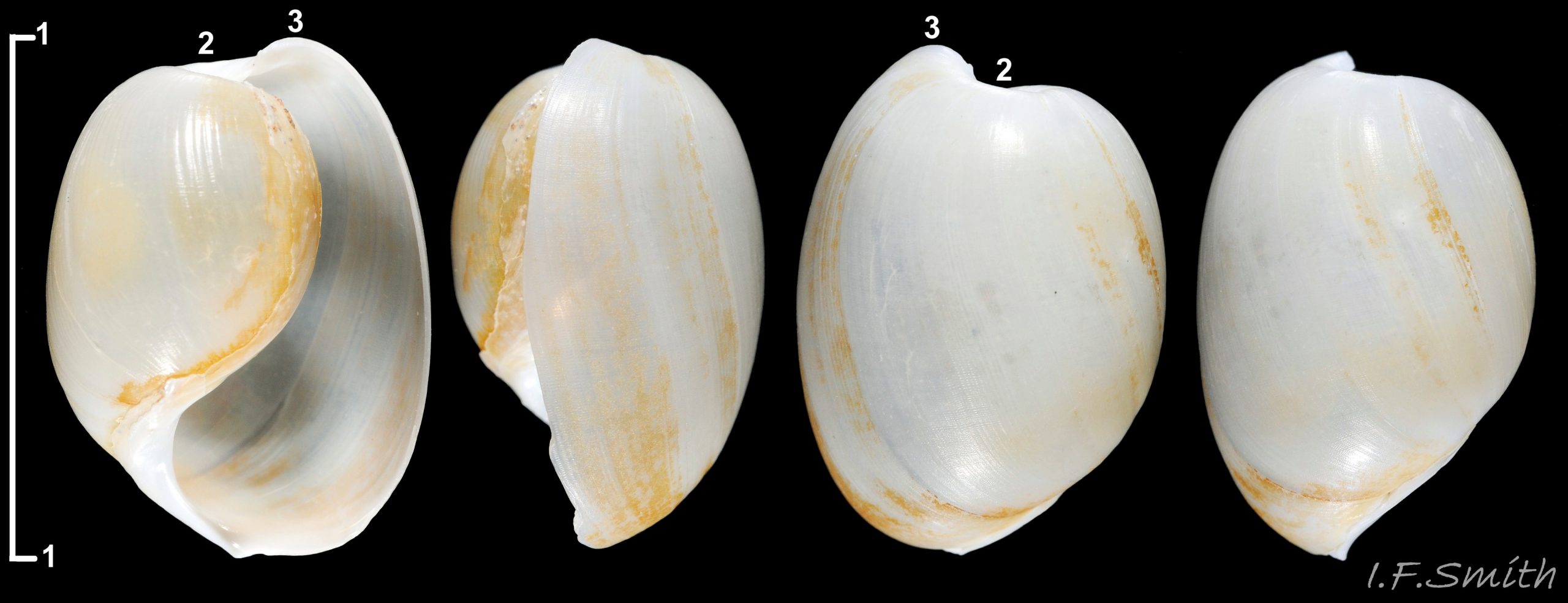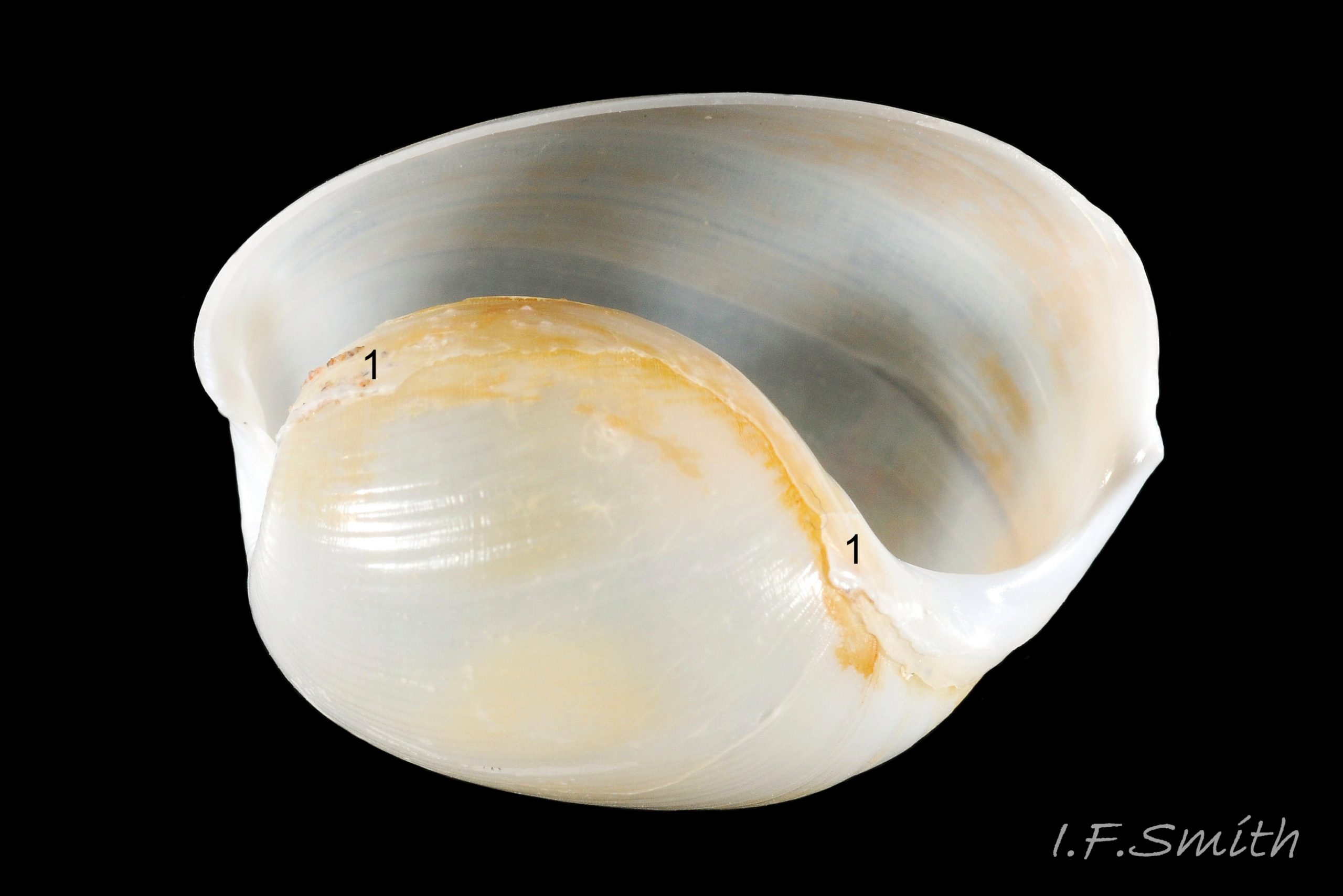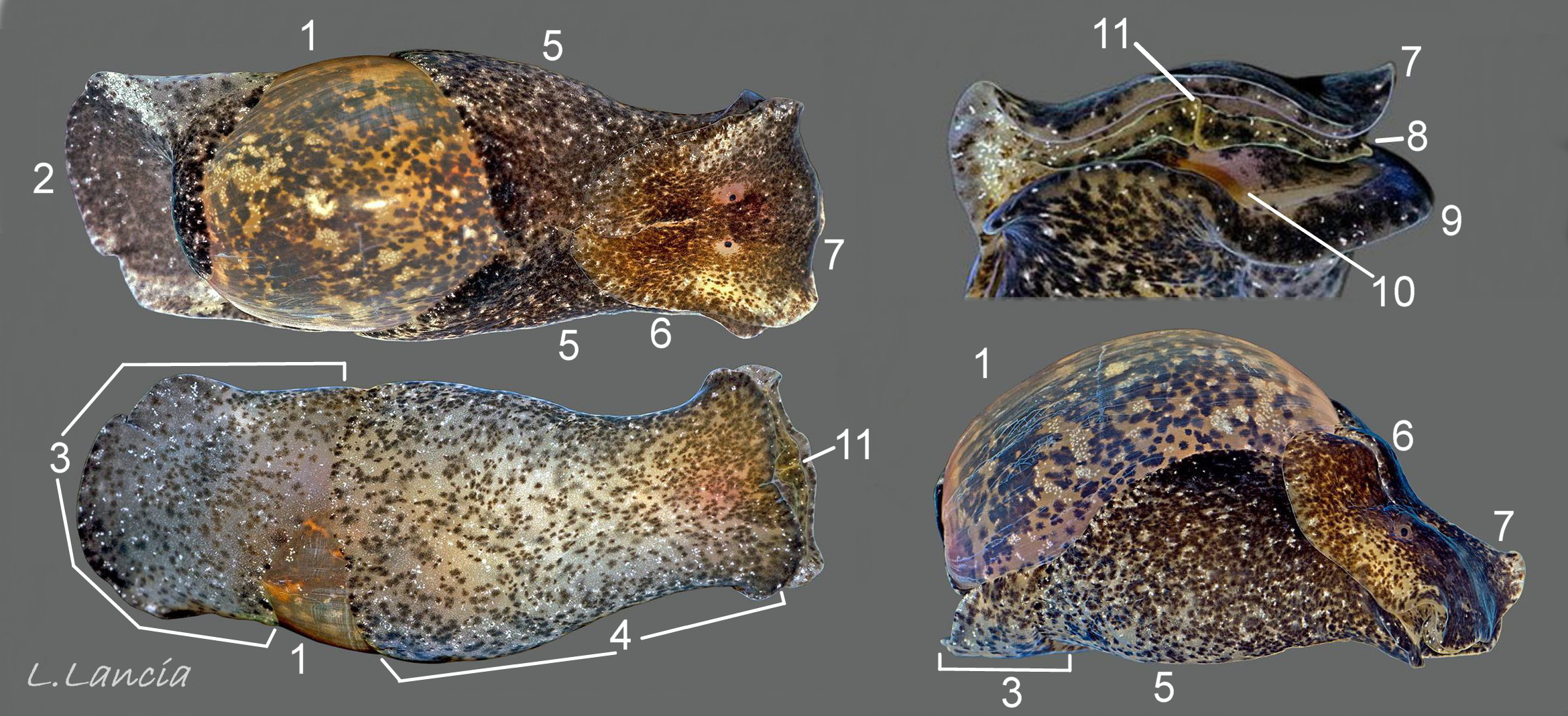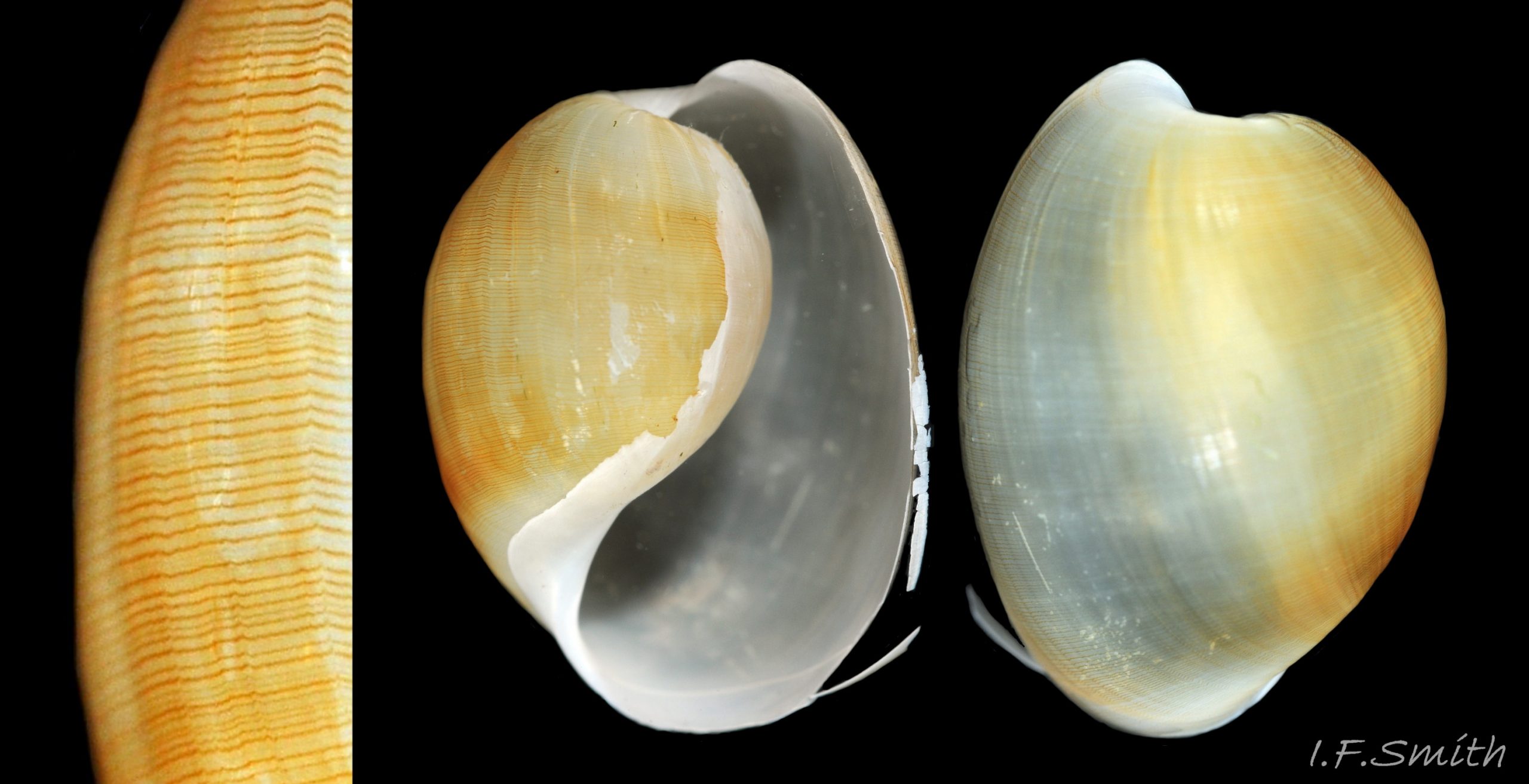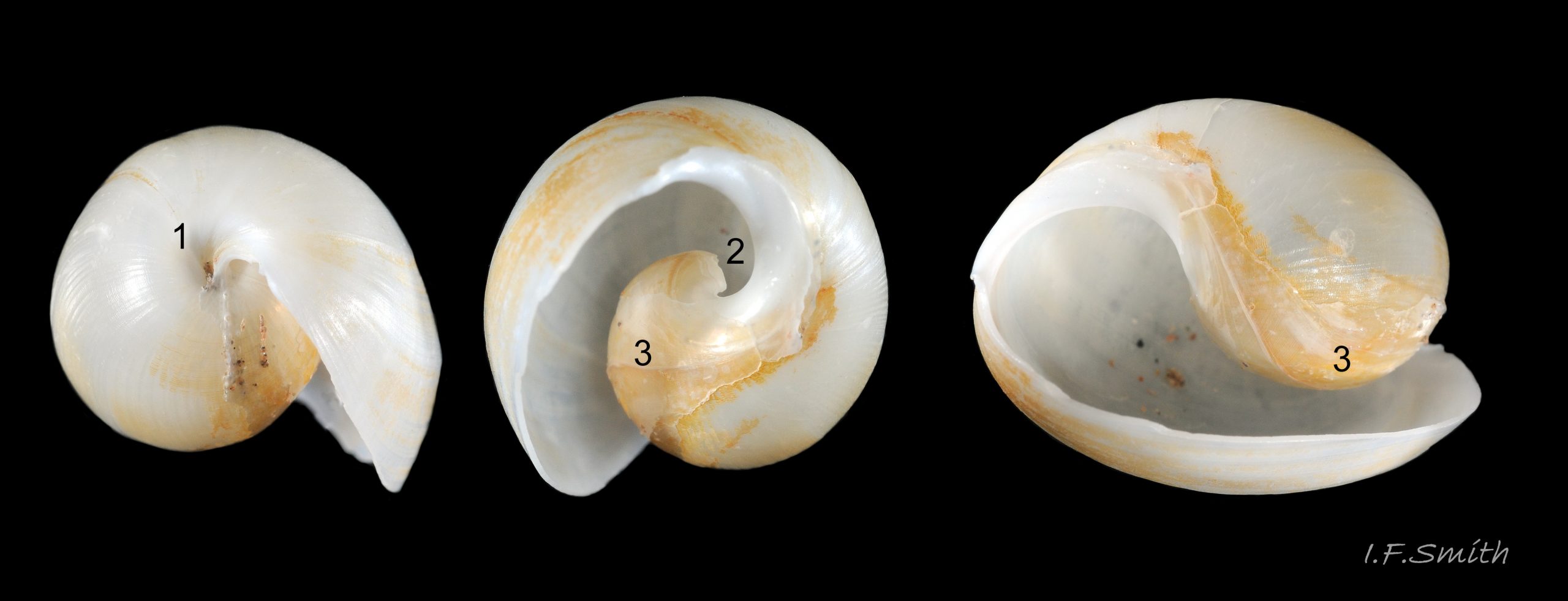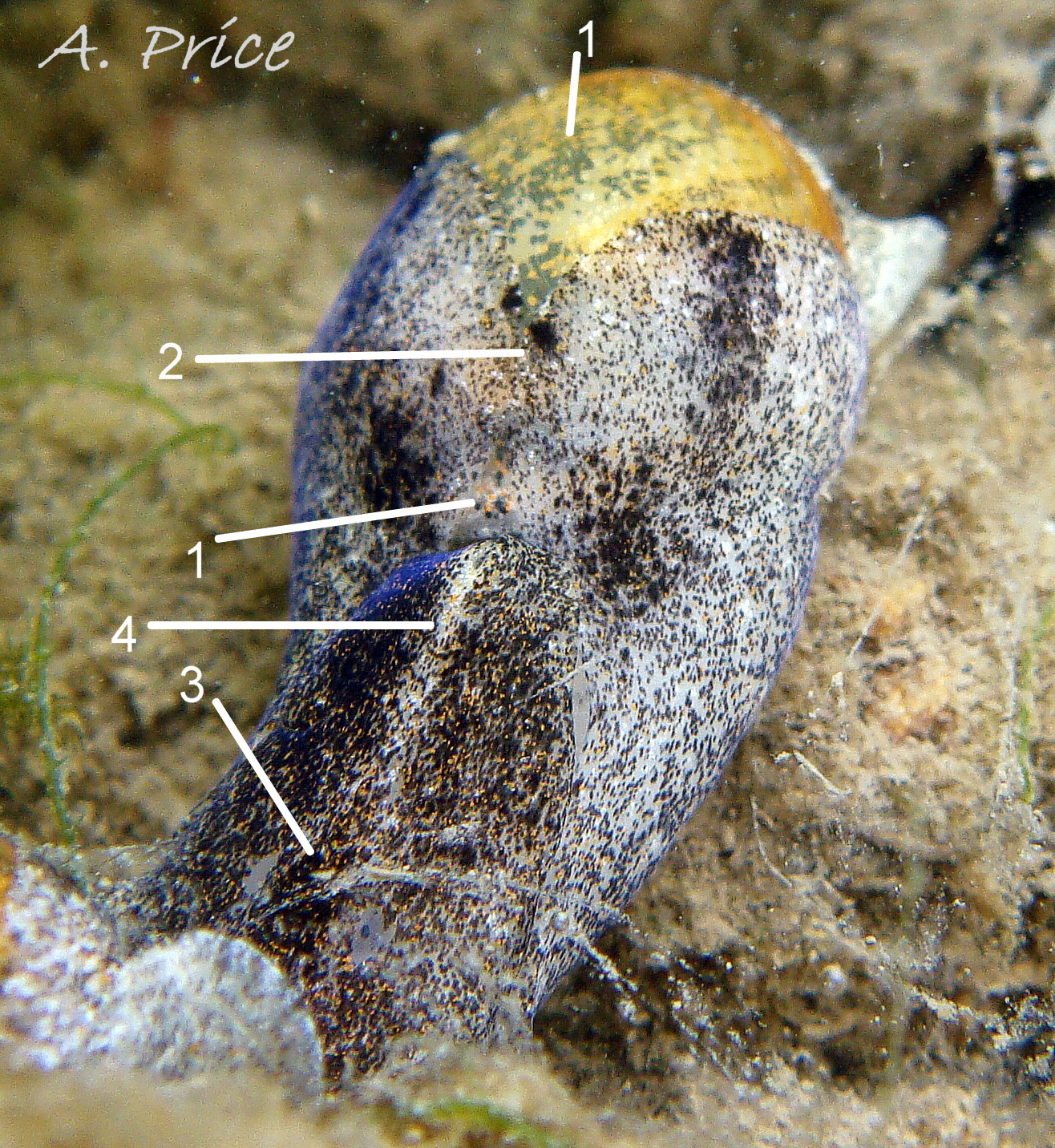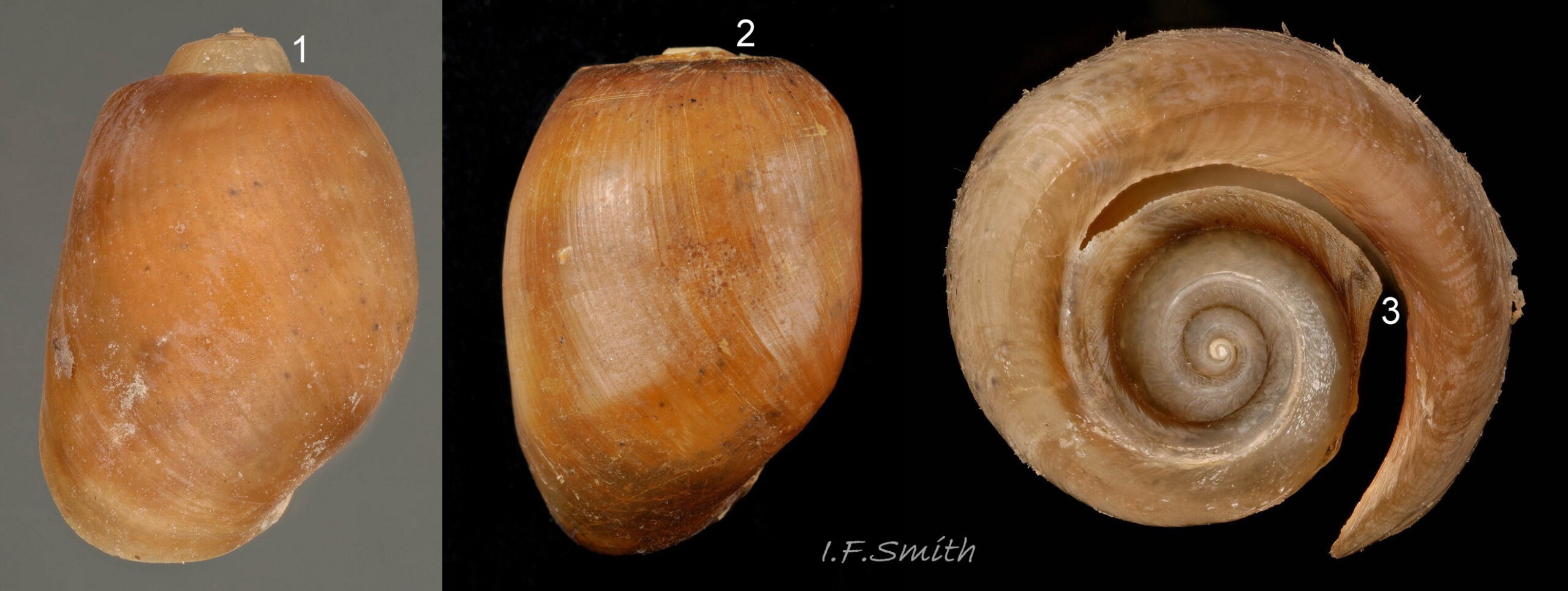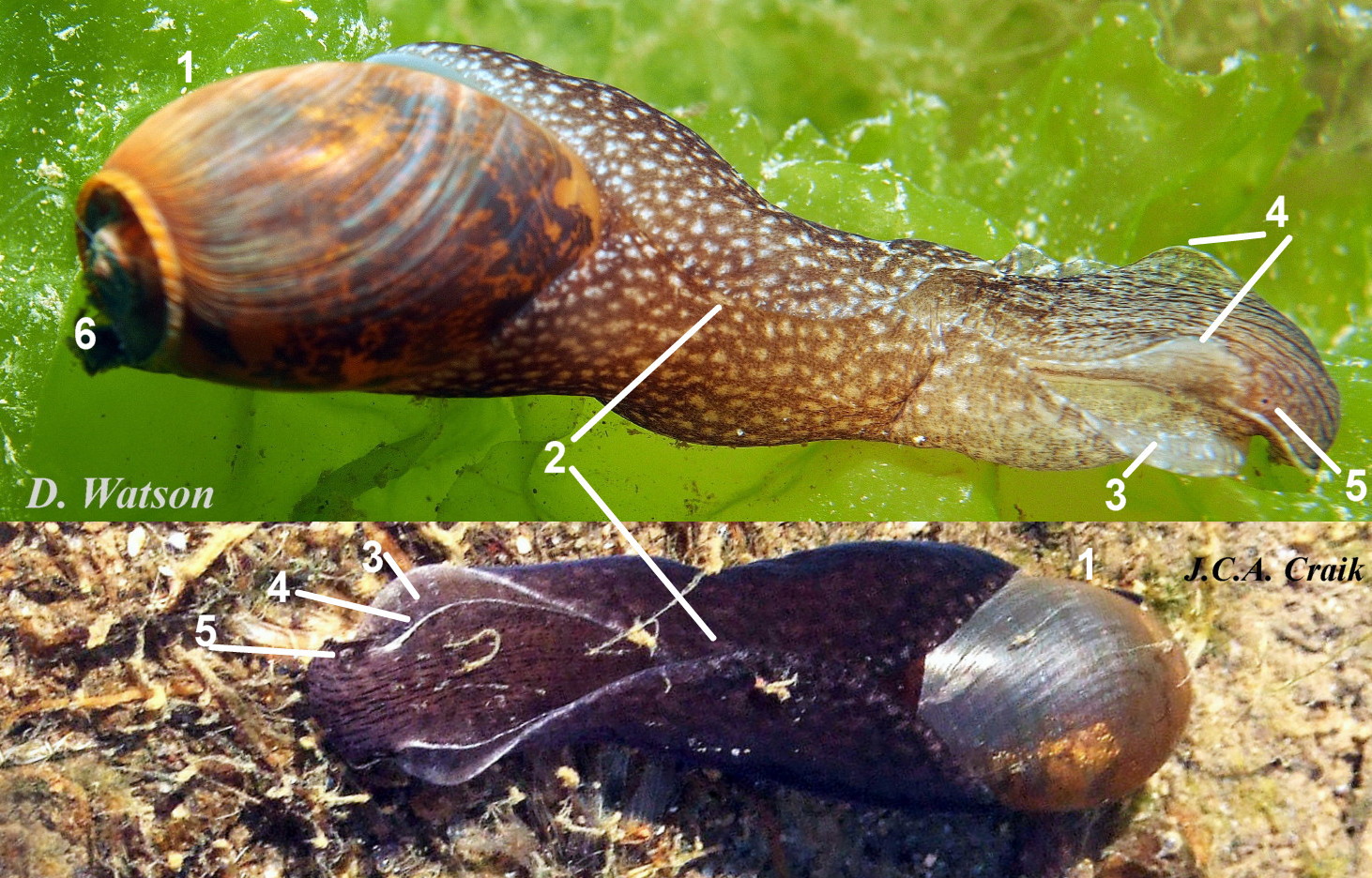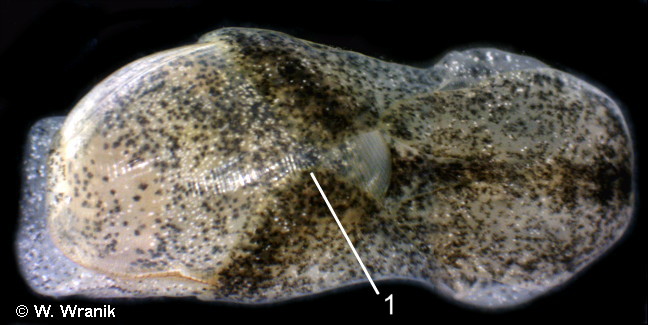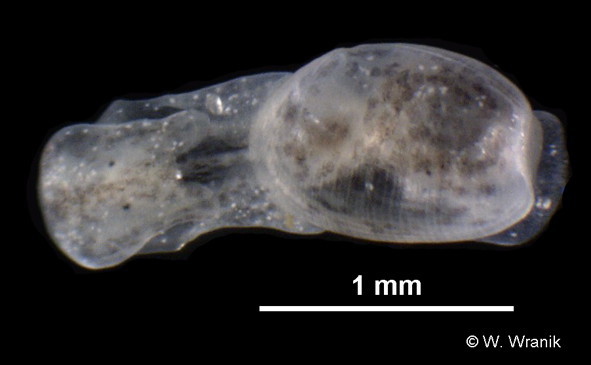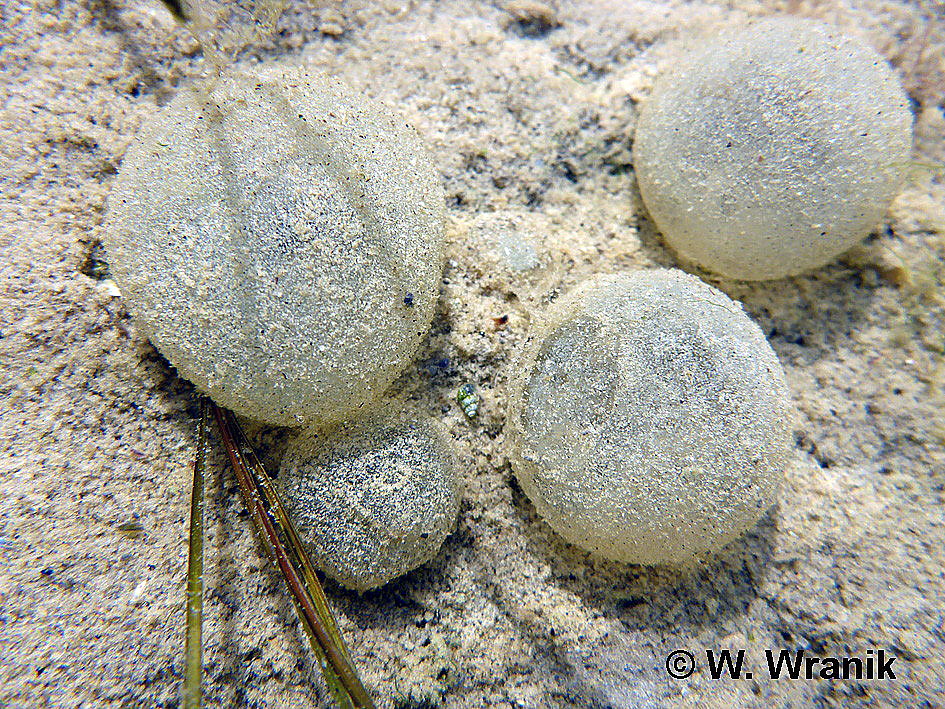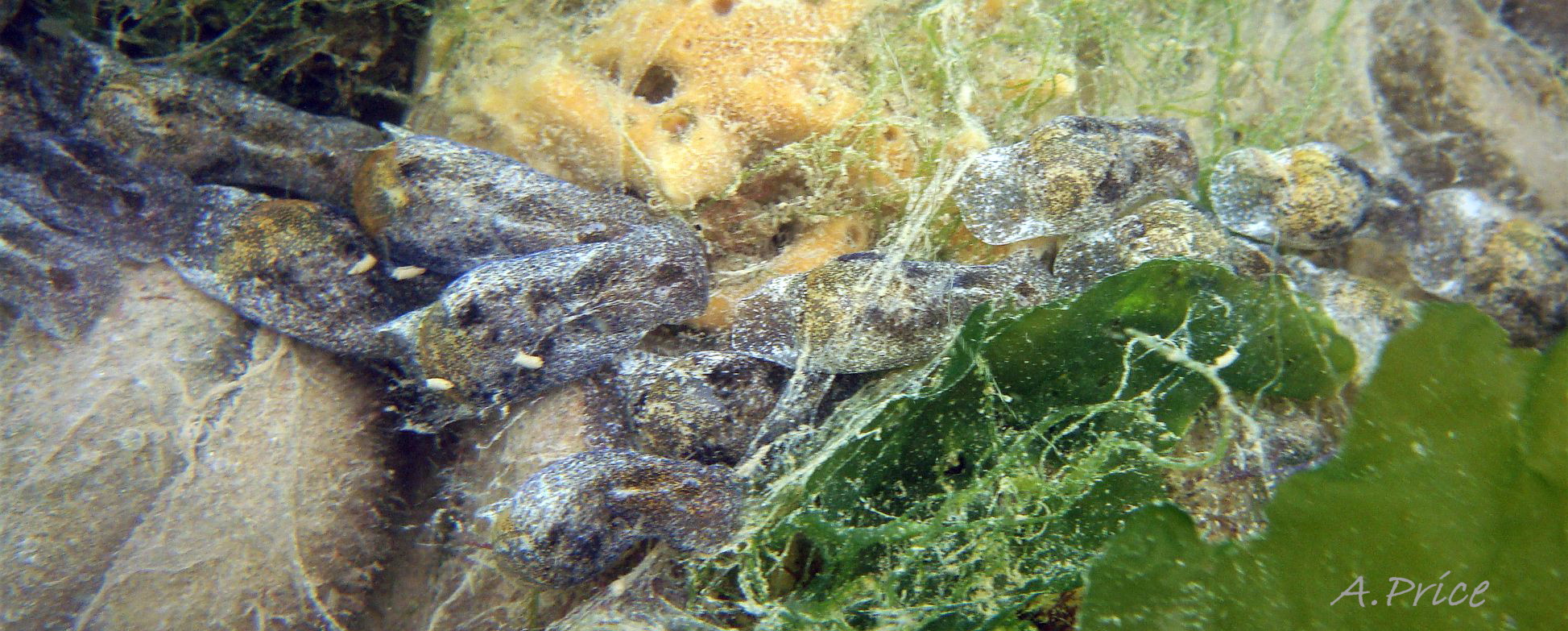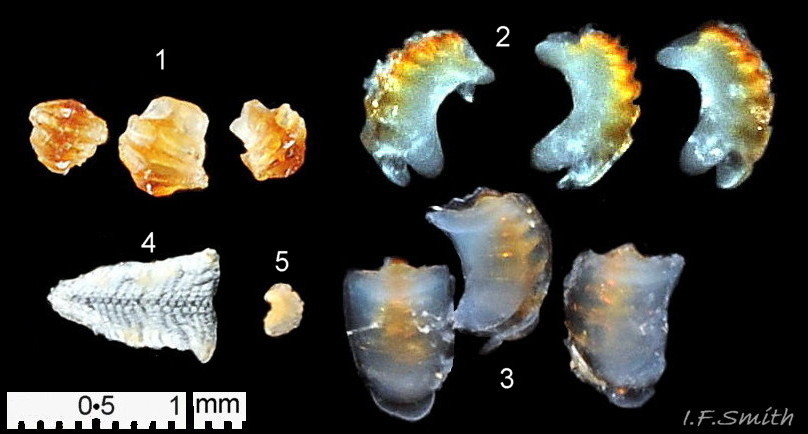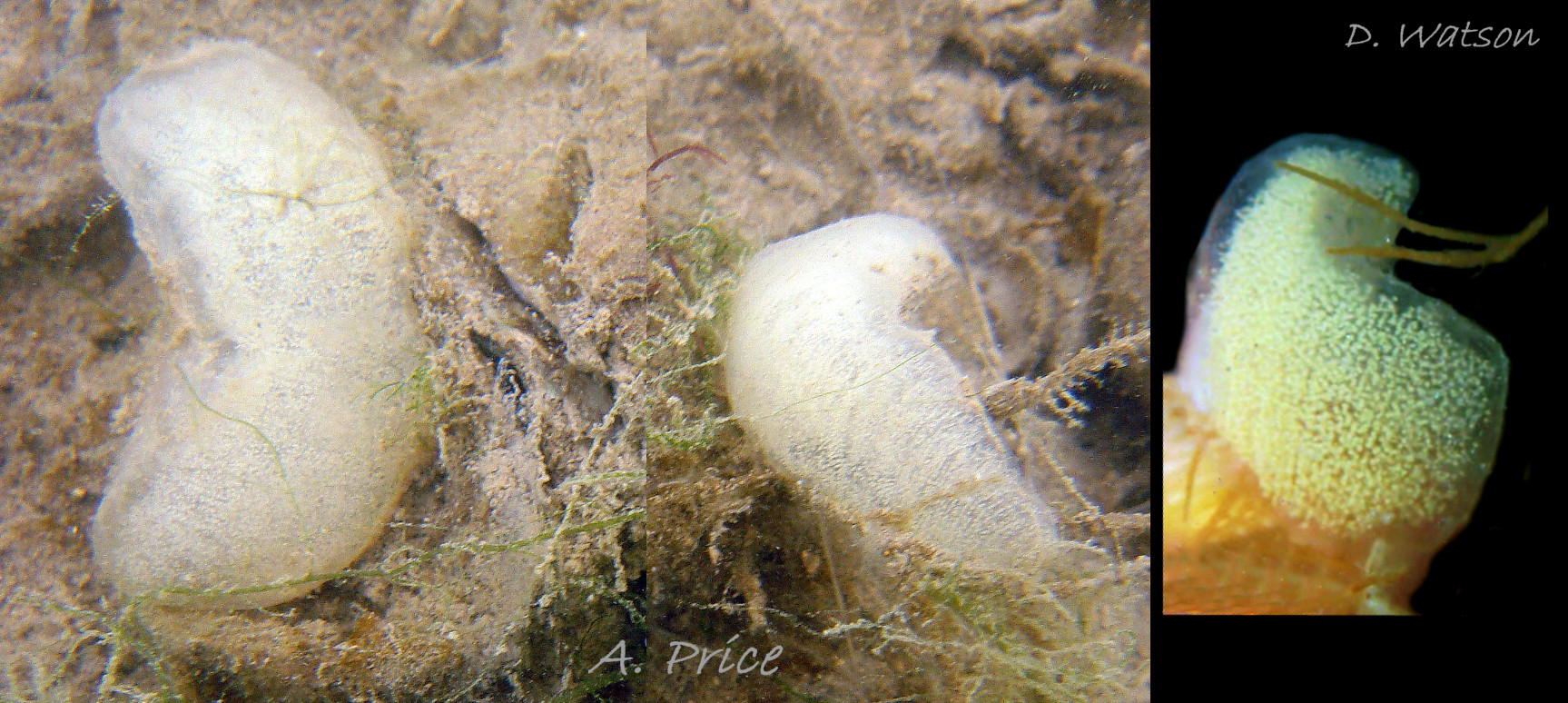Click image to enlarge with full caption. Main text below slider.
Haminoea navicula (da Costa, 1778)
Synonyms: Bulla navicula da Costa, 1778; Bulla cornea Lamarck, 1822; Haminoea cornea (Lamarck, 1822); Bulla hydatis auct. non Linnaeus.
Current taxonomy: World Register of Marine Species (WoRMS)
http://www.marinespecies.org/aphia.php?p=taxdetails&id=140075
Meaning of name:Bulla (Latin) = bubble; navicula (Latin) = small boat, a skiff.
Vernacular: (of this and related species) Bubble shell; Kopfschildschnecke (German).
GLOSSARY below.
Shell description
The shell grows up to 32 mm high in Britain (longest dimension; top of protruding aperture to base of shell) 01 Haminoea navicula over 50 mm high in Mediterranean. It is a very thin, fragile, slightly glossy, translucent, white, swollen ‘bubble’, with fine growth lines and spiral striae visible at 10X magnification when tilted to catch the light 02 Haminoea navicula . In close view, the spiral striae are slightly jagged because the segment between each pair of growth lines is slightly offset from the segment between the adjacent pairs of growth lines 03 Haminoea navicula. When present, the slightly jagged spiral striae are diagnostic in northwest Europe, but they are weakly developed on young shells 02 Haminoea navicula, are often partially or completely worn off dead beached shells 04 Haminoea navicula and usually indiscernible on in situ images of live specimens 05 Haminoea navicula & 06 Haminoea navicula .
Fresh shells have a brownish yellow periostracum 07 Haminoea navicula. On beached shells it survives best on the body whorl just within the aperture where it is overlaid by nacre 04 Haminoea navicula. The involute spire, sunk below the encompassing final whorl, resembles an umbilicus 08 Haminoea navicula. No suture is visible as the spire is involute. The long aperture extends distinctly higher than the spire 01 Haminoea navicula. Internally, all whorls open to and spiral round a wide central cavity instead of a solid columella 08 Haminoea navicula. There is no operculum.
Body description
Haminoea navicula grows to a maximum length of 70 mm (Thompson, 1976). The ground colour of pale fawn to whitish is overlaid by dark brown pigment specks 05 Haminoea navicula which are often so dense as to give a general dark brown or blackish appearance 09 Haminoea navicula. In addition there may be some white and orange specks. There is often a distinct dark patch behind the eyes and sometimes a white line running back from it to the parting between the cephalic lobes 10 Haminoea navicula & 11 Haminoea navicula .The translucent shell often reveals the mantle within, which is dull orange with dark blotches 05 Haminoea navicula & 11 Haminoea navicula. The head is covered by a large cephalic shield which has black eyes with white surrounds positioned on it dorsally and, behind the eyes, small lateral flattened cephalic lobes 09 Haminoea navicula which conceal the anterior of the shell.
The foot extends laterally into parapodia which, when fully extended, conceal the sides of the shell but only a small part of its dorsum. If they meet, it is with no, or insignificant, overlap 10 Haminoea navicula & 11 Haminoea navicula. There is no discernible dividing line between the sole and the parapodia 06 Haminoea navicula. The mantle emerges as the posterior pallial lobe from the (adapical) posterior of the shell aperture and covers the spire of the shell; it also extends to form the posterior of the animal and can be mistaken for the foot 05 Haminoea navicula & 06 Haminoea navicula.
Key identification features
Haminoea navicula
1) Shell maximum height 32 mm in Britain. Brownish yellow periostracum. Slightly jagged spiral striae visible on fresh shell in good light under magnification 03 Haminoea navicula & 07 Haminoea navicula Diagnostic when present but faint on juveniles 02 Haminoea navicula, easily worn off dead shells 04 Haminoea navicula and usually indiscernible on in situ images of live specimens 05 Haminoea navicula & 06 Haminoea navicula.
2) Involute spire resembles an umbilicus 08 Haminoea navicula; aperture extends beyond it 01 Haminoea navicula.
3) Body maximum length 70 mm.Trapezoidal cephalic shieldhas two small posterior lobes which cover the anterior of the shell 09 Haminoea navicula.
4) Cephalic shield hasdorsal eyes in unpigmented patches 09 Haminoea navicula; sometimes difficult to discern among dark pigment spots 05 Haminoea navicula .
5) Long tall parapodial lobes may meet for a short distance on the dorsum medially with no, or small, overlap 10 Haminoea navicula & 11 Haminoea navicula.
6) Wide flat pallial lobe extends from posterior 10 Haminoea navicula & 05 Haminoea navicula.
7) West coast of Ireland and south coast of England reaching north as far as Suffolk, South Wales and Donegal, Ireland and south to Mediterranean including the Adriatic.
8) Spawn a short, broad ribbon 20 mm to 75 mm long, curved like half a wedding ring.
Similar species
Haminoea hydatis (Linnaeus, 1758).
Shell lectotype at https://linnean-online.org/16897/#?s=0&cv=0&z=-0.116%2C-0.0013%2C1.232%2C1.5055 H. hydatis is the type species of the genus Haminoea, but its features are uncertain and authors differ; see appendix below. Although a Mediterranean species, it was omitted from Prkić et al. (2018) because of uncertainty about its features. For the same reason, no images are shown here.
1) Shell often smaller than a pea (Linnaeus, 1758), maximum height 16 mm (Lamarck, 1822). Semi-transparent shell reveals orange and white spots on mantle, and the periostracum is thin, transparent, greenish yellow (Gofas & Salas, 2011). Faint growth lines. Spiral striae absent (Malaquias, & Cervera, 2006) and none are visible in the image of the lectotype in the Linnean Shell Collection. Caution: unless shell is fresh, mature, well lit and magnified, striae are often indiscernible on H. navicula which could be then mistaken for H. hydatis.
2) Involute spire, aperture extends a little beyond it.
3) Maximum extended length of body 25 mm, light brown with numerous dark gray spots, and cephalic shield has deeply bilobed posterior margin (Gofas & Salas, 2011).
4) Cephalic shield has dorsal eyes in unpigmented patches (Malaquias, & Cervera, 2006).
5) Small parapodia cover only anterior sides of shell and do not extend to meet dorsally (Malaquias, & Cervera, 2006).
7) Mediterranean (Linnaeus, 1758), probably Atlantic France (Gofas & Salas, 2011), a few uncertain reports from Channel Islands (Sowerby, 1859). Pre 1932 records of H. hydatis in Britain were misidentified H. navicula; see appendix below.
Akera bullata O. F. Müller, 1776
1) Shell up to 30 mm, rarely 40 mm, high. Spiral slit in suture between whorls, sealed by membrane on early whorls.
2) Truncated spire, not involute, protrudes a little beyond final whorl or hardly at all 12 Haminoea navicula.
3) Maximum extended length of body usually 40 mm, rarely 80 mm. Grey or brownish to black with light and dark blotches and streaks.
4) Eyes on sides of head with ear-like lobes behind them 13 Haminoea navicula.
5) Parapodial lobes meet over body and overlap.
6) No large pallial lobe extends from posterior.
7) Northern Norway to the Aegean. Widely scattered sites in Britain and Ireland.
8) Spawn a long, white or yellow-white string tangled around algae,
Haloa japonica (Pilsbry, 1895). 14 Haminoea navicula
(Synonym: Haminoea callidegenita).
1) Shell maximum height 20 mm. Semi-transparent, slightly yellowish shell reveals orange spots on mantle. Very fine, spiral lines on shell, much more inconspicuous than on Haminoea navicula.
3)Body maximum length 35 mm, translucent whitish with opaque white and brown spots; brown densest on parapodia and centre of cephalic shield where orange-brown buccal mass may also be visible.Long cephalic lobes usually overlap each other.
4) Cephalic shield hasdorsal eyes in unpigmented patches
5) Often parapodia cover only anterior sides of shell but can extend to meet dorsally with little or no overlap.
6) Posterior pallial lobe can extend considerably.
7) Japan and south-east Asia. Introduced to Pacific North America and to Europe between Netherlands, Iberia and Mediterranean. Not Britain in 2024. Salinity 20‰ to 45‰ , optimum 30‰ to 40‰ (Trkov et al. 2024).
8) Irregular spawn mass contains large yellow ova, attached to vegetation.
Haminella solitaria (Say, 1822).
Main information source: Wranik (2018).
1) Maximum shell height 12 mm in Baltic, occasionally 20 mm in USA. Thin brown periostracum quickly lost after death leaving whitish shell. Smooth spiral lines on shell; not slightly jagged 15 Haminoea navicula.
2) Involute spire resembles an umbilicus; aperture extends slightly beyond it, but not as far as on H. navicula 15 Haminoea navicula.
3)In Germany, extended body length about 20 mm in July/August; smaller sizes, 2 to 4 mm, found in October/November and Spring. Posterior of cephalic shielddeeply incised into two large pointed lobes which sometimes overlap each other 16 Haminoea navicula.
4) Eyes hidden by opaque tissue on adults 16 Haminoea navicula and but visible through cephalic shield of juveniles 18 Haminoea navicula.
5) Parapodial lobes may meet on the dorsum medially and sometimes overlap 16 Haminoea navicula & 17 Haminoea navicula.
7) North America from Gulf of Saint Lawrence to South Carolina, unconfirmed reports from Florida. Introduced c. 2016 in Baltic waters of Germany, Denmark, Norway and south coast of Sweden. Not Britain 2024.
8) Spherical spawn mass, c. 20 mm diameter 19 Haminoea navicula ; anchored in sediment by narrow extension.
Other European Haminoeidae
From Mediterranean and southern Europe, but not recorded in Britain:
Haminoea exigua (Schaefer, 1992), H. fusari (Alvarez, Garcia & Villani, 1993), H. orbignyana (Férussac, 1822), H. orteai Talavera, Murillo & Templado, 1987 and H. templadoiGarcia, Perez-Hurtado & Garcia-Gomez, 1991.
Habits and ecology
H. navicula lives intertidally and in the shallow sublittoral on mud and muddy sand, with Ulva or Zostera in lagoons, estuaries, tidal rivers and other sheltered waters, often at low salinity. It cannot swim, except as a larva. Adults crawl, often in a procession 20 Haminoea navicula with each following, by feel and/or by chemoreception, the mucus band left by its predecessor 10 Haminoea navicula.
Its diet is uncertain, but is probably similar to that of the related H. orbygniana which is “ herbivorous, stenophagic and probably non-selective, feeding mainly on diatoms (67.61%) and occasionally on vegetal detritus (4.16%) and Foraminifera (0.04%), but also including sand grains as an important part of the gut contents (28.34%).” (Malaquias et al., 2004). H. navicula gathers food with a pair of jaws and a radula with about 18 rows of teeth. It has a gizzard in its foregut with three curved plates bound into a bundle by strong muscles 21 Haminoea navicula. The plates’ tapered, curved anteriors form the opening of a funnel through which food, including the hard frustules of diatoms, enters to be ground by 8-15 ribs on the convex, inner surface of each plate, which is stained rufous and yellow probably by hardening minerals. The concave whitish outer surface of each plate is smooth.
The speckling of the body disrupts its outline and matches well the substrates it lives on. It breeds in spring and summer in Britain and the Atlantic coast of France. Spawn is produced in short thick bands, length 20 mm to 75 mm, which curve to resemble half a wedding ring 22 Haminoea navicula . A mass 55 mm long contains about 7700 ova (Malaquias et al. 2006). Veliger larvae emerge from the ova and live in the plankton for a time before settling and metamorphosing.
Distribution and status
H. navicula occurs from the west coast of Ireland and south coast of England reaching north as far as Essex, South Wales and Donegal, Ireland and south to the Mediterranean including the Adriatic. GBIF map http://www.gbif.org/species/2291477 ; the isolated record in southern Norway is most probably a misidentified Haminella solitaria which is established in the area. U.K. map NBN https://species.nbnatlas.org/species/NBNSYS0000175664 .
Appendix; use of Bulla hydatis auct. as name of H. navicula.
Linnaeus (1758) described specimens from the Mediterranean as Bulla hydatis thus (in translation), ‘Shell rounded, transparent, longitudinally substriated [= faint growth lines], apex like an umbilicus. Size often smaller than a pea’. Two of his specimens survive in the Linnean Shell collection and the image of one regarded as the lectotype is at https://linnean-online.org/16897/#?s=0&cv=0&z=-0.116%2C0%2C1.232%2C1.503 . Subsequently, the name was used by many authors for larger specimens from Britain.
Da Costa (1778) described such specimens from Weymouth, England, in more detail, calling them Bulla navicula (da Costa, 1778). There were some differences; larger size, that of a ‘filberd’ (hazel nut) and ‘extreme fine transverse striae, hardly perceivable’ [= fine spiral striae], but British authors continued use of B. hydatis auct., encouraged no doubt by da Costa indicating he thought that it was the same as B. hydatis Linnaeus 1758 by putting its name and the description by Linnaeus at the start of his new description.
Lamarck (1822) accepted two species; Bulla hydatis Linnaeus 1758 with small size (maximum length 16 mm) from the Mediterranean and Bulla cornea Lamarck 1822 with larger size (maximum length 22.5 mm) from Britain, matching the description and region of Bulla navicula da Costa 1778. Sowerby (1859) followed Lamarck with Bulla hydatis Linnaeus 1758 and Bulla cornea Lamarck 1822, with synonym for the latter stated as B. navicula da Costa 1778, but most British workers continued applying the name B. hydatis auct. to B. navicula da Costa 1778.
Both Forbes and Hanley (1853) and Jeffreys (1867) admitted the possibility of two species but continued to use the name Bulla hydatis auct. for the larger, spirally striated Bulla navicula da Costa found in Britain, and most other British authors did likewise. The detailed descriptions and images in Forbes and Hanley (1853) and Jeffreys (1867) leave no doubt of them fitting the description of Bulla navicula da Costa. Jeffreys mentioned the genus name Haminæa or Haminea (misspellings of Haminoea Turton & Kingston, 1830), but did not adopt use of it.
British authors (Chaster et al. 1901; Marshall 1912, McClelland 1923, and Step 1927) continued use of B. or H. hydatis auct. for H. navicula until about the time when Winckworth (1932) published a British list with Haminoea hydatis (Linnaeus, 1758) and Haminoea navicula (da Costa,1778), [referencing to Forbes & Hanley and Jeffreys’ descriptions of the latter as B. hydatis auct.]
Winckworth’s usage has continued to the present (McMillan 1968, Thompson 1976, Seaward 1982 and WoRMS accessed April 2024.) This is reflected on NBN Atlas (accessed April 2024) which has 103 records of H. navicula (da Costa, 1778) on the south coast of England reaching north as far as Suffolk, South Wales and Donegal, Ireland. For H. hydatis (Linnaeus 1758), which probably gets no further north than the Channel Islands, NBN has a few very dubious records. They are Tenby, Wales in 1899 and Walton-on-the Naze, Essex in 1907 when the name was misused for H. navicula (da Costa 1778), which was found living c. 10 km from Walton in Essex in 2019 and Suffolk in 2020, three highly improbable records in Shetland in 1995 and one from an oil platform in the northern North Sea in 1988 hundreds of kilometres north of the probable limit of H. hydatis in the Channel Islands.
Acknowledgements
I thank Holly Morgenroth, Adrian Price, Kate Rose, Malcolm Storey and Steve Trewhella for providing specimens to photograph, and Frédéric Andre, Clive Craik, Marina Kapeller, Leo Lancia, Johan Prehn, Adrian Price, Jakov Prkić, Rob Spray, Rino Stanić, Dawn Watson and Wolfgang Wranik for use of images. The information provided by Jakov Prkić and Wolfgang Wranik is gratefully acknowledged.
References and links
Chaster, G.W., Knight, G.A.F., Melvill, J.C. and Hoyle, W.E. 1901. List of British marine mollusca and brachiopoda. Manchester, Conchological Society of Great Britain and Ireland. p. 17.
Costa, E.M. da. 1778. Historia naturalis testaceorum Britanniae or, the British conchology. London, Milan, White, Elmsley & Robson. p 28. https://www.biodiversitylibrary.org/page/13116783#page/48/mode/1up
Forbes, E. & Hanley S. 1853. A history of the British mollusca and their shells. vol. 3, London, van Voorst. (H. navicula as Bulla hydatis) 530-533. https://archive.org/stream/ahistorybritish05forbgoog#page/n544/mode/2up/search/navicula .
Vol 1, Plate UU, live specimen (H. navicula as Bulla hydatis) https://archive.org/stream/historyofbritish01forb#page/n733/mode/2up
Vol. 4, Plate cxiv D, vacant shell (H. navicula as Bulla hydatis) https://archive.org/details/historyofbritish04forbe/page/n589/mode/2up
Fretter, V. 1939. The structure and function of the alimentary canal of some tectibranch molluscs, with a note on excretion. Trans. Roy. Soc. Edinb. 59 : 599 – 646.
Garstang, W. 1890. A complete list of the opisthobranchiate mollusca found at Plymouth; with further observations on their morphology, colours and natural history. J. mar. biol. Ass. U.K. 1(4): 399-457. http://plymsea.ac.uk/50/ .
Gofas, S. and Salas, D.M. & C. 2011 Moluscos marinos de Andalucía Universidad de Málaga.
Jeffreys, J.G. 1862-69. British conchology. vol. 4 (1867). London, van Voorst. pp. 437 to 439 (as Bulla hydatis) https://archive.org/stream/britishconcholog04jeff#page/436/mode/2up .
Lamarck, [J.-B. M.] de. (1822). Histoire naturelle des animaux sans vertèbres. Tome sixième, 2me partie. Paris: published by the Author, 232 pp.
https://www.biodiversitylibrary.org/pdf4/1692679i00047441.pdf
Linnean Society, The Linnean Shell Collection https://linnean-online.org/shells.html . As Bulla hydatis https://linnean-online.org/16897/#?s=0&cv=0&z=-0.116%2C0%2C1.232%2C1.503
Linnaeus, C. 1758. Systema naturae. ed. 10. Holmiae, Laurentii Salvii.
p. 726 description of H. hydatis as Bulla hydatis. https://www.biodiversitylibrary.org/page/726886#page/747/mode/1up
Malaquias, M.A.E. and Cervera, J.L. 2006. The genus Haminoea (gastropoda: cephalaspidea) in Portugal, with a review of the European species. J. Moll. Stud., 72: 89–103 https://doi.org/10.1093/mollus/eyi052
Comparative matrix https://academic.oup.com/view-large/20465658
Malaquias, M.A.E., Condinho, P.S., Cervera, J.L. and Sprung, M. 2004. Diet and feeding biology of Haminoea orbygniana (Mollusca: Gastropoda: Cephalaspidea). J. Mar. Biol. Ass. U.K., 84: 767-772.
Marshall, J. T. 1912. Additions to ‘British Conchology’ J. Conch. 13 (11): 324 – 338. p. 337.
McClelland, H. 1926. General index of all families, genera, species and varieties described and noted in the Journal of Conchology vols. I – XVI, 1874 to 1922. Proceedings of the Malacological Society of London vols. I – XV, 1893 to 1923. The Conchologist vols I – II, 1891 to 1893, continued as the Journal of Malacology vols. III – XII, 1894 to 1905. Birmingham, Birbeck and sons. p.78.
McMillan, N.F. 1968. British shells. London, Frederick Warne & co.
Prkić, J., Petani, A., Iglić, Đ. and Lanča, L. 2018. Opisthobranchs of the Adriatic Sea. Photographic atlas and list of Croatian Species. Croatia.
Seaward, D.R. 1982. Sea area atlas of the marine molluscs of Britain and Ireland. Shrewsbury, Nature Conservancy Council for the Conchological Society of G.B and Ireland.
Sowerby, G.B. 1859. Illustrated index of British Shells. London, Simkin, Marshall & co.
Step, E. 1927 (New edition). Shell life, an introduction to the British mollusca. London, Frederick Warne & co.
Talavera, P., Murillo, L. and Templado, J. 1987. The genus Haminoea Turton and Kingston, 1830 (Opisthobranchia, Bullomorpha) in the southeast of Spain with the description of a new species. Boll. Malacologico, Milano. (23): 53 – 68. https://www.biodiversitylibrary.org/page/49931247#page/63/mode/thumb
Thompson, T.E. 1976. Biology of opisthobranch molluscs vol.1. London, Ray Society.
Trkov, D., Praprotnik, E. and Lipej, L. 2024. Salinity Tolerance of Non-Native Heterobranch Sea Slug Haloa japonica Pilsbry, 1895. https://www.researchgate.net/publication/377683533_Salinity_Tolerance_of_Non-Native_Heterobranch_Sea_Slug_Haloa_japonica_Pilsbry_1895
Turk, S.M. 1973. Concordance to the field card for British marine mollusca. London, the Conchological Society of Great Britain and Ireland. p. 34.
Vayssière, M.A. 1880.Recherches anatomiques sur les mollusques de la famille des Bullidés. Annales Sciences Naturelles Zoologie 9: 1 – 123.
Vayssière, M.A. 1885.Recherches zoologiques et anatomiques sur les mollusques opistobranches du golfe de MarseilleAnnales du Muséum d’Histoire Naturelle Marseille, Zoologie 2 (3): 1 -181. https://www.biodiversitylibrary.org/item/44228#page/9/mode/1up
Winckworth, R. 1932. The British marine mollusca. J. Conch. 19: 211-252. p.231
Wranik, W. and Malaquias, M.A.E. 2018. Zum Auftreten der Kopfschildschnecke Haminoea solitaria (Say, 1822) im Bereich der deutschen Ostseeküste. Mitt. dtsch. malakozool. Ges. http://www.dmg.mollusca.de/images/mitteilungen_dmg/mitteilungen099/mitt_dmg_099_001-020_wranik-haminoea.pdf
Glossary
auct. = (abbreviation of “auctorum”) of authors. (Used when citing name, often of another valid species, used in error by some authors).
aperture = mouth of gastropod shell; outlet for head and foot.
ELWS = extreme low water spring tide (usually near March and September equinoxes).
euryhaline = able to tolerate a wide variation in salinity.
frustule = the hard external siliceous layer of diatoms.
lectotype = single specimen selected from a group of syntypes and designated as the name-bearing type some time after the original description was published.
mantle = sheet of tissue that secretes the shell and forms a cavity for the gill in most marine molluscs. Confined to the shell-interior of most British shelled-gastropods.
operculum = plate of horny conchiolin used to close shell aperture of gastropods. Absent from Haminoea .
periostracum = thin horny layer of chitinous material often coating shells.
plankton = animals and plants that drift in pelagic zone (main body of water).
siliceous = consisting of silica
stenophagic = having a highly specialized diet.
syntype = each of a set of type specimens of equal status, upon which the description and name of a new species is based.
umbilicated = resembling an umbilicus (navel).
veliger = shelled larva of marine gastropod or bivalve mollusc which swims by beating cilia of a velum (bilobed flap).
